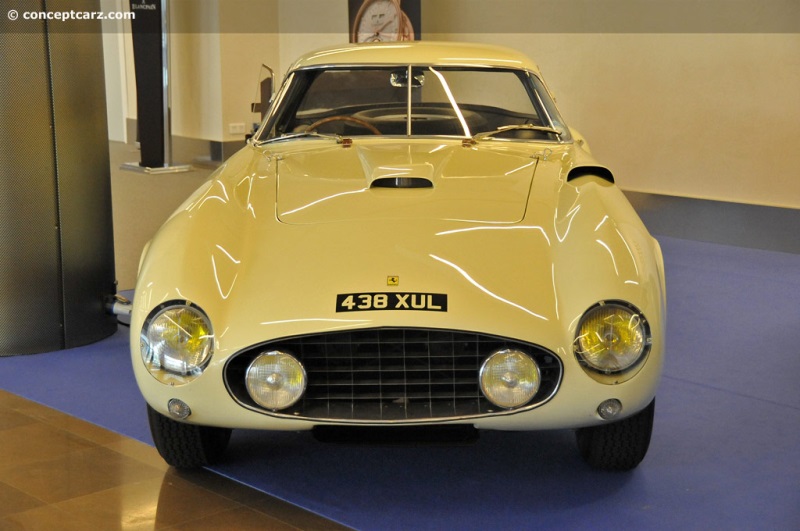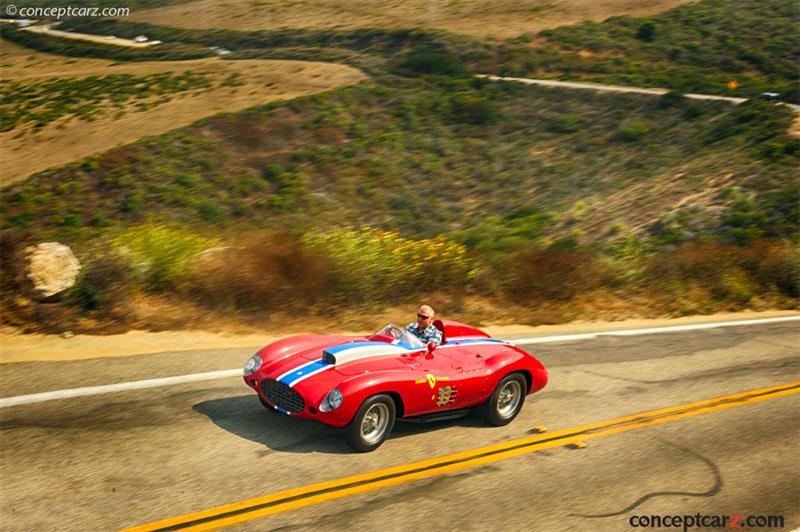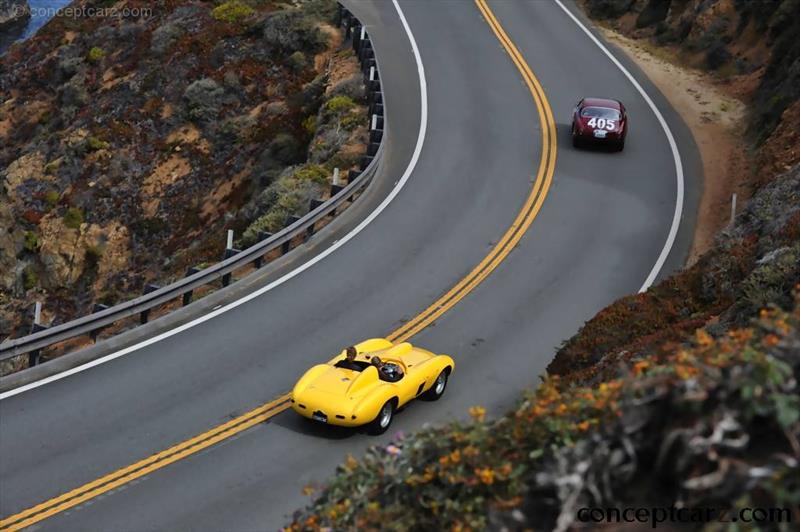History
In 1949 the Ferrari twelve-cylinder engine was 1.5 liters in size; by 1953 the displacement size had grown to 5 liters. In 1954 a 375 Plus, powered by a 4.9-liter engine, was entered in the grueling 24 Hours of LeMans where it captured the overall victory. Further development of the engines continued with the focus slowly shifting toward smaller displacements with fewer cylinders. The idea was that a lighter, smaller, more compact engine could prove to be a potent contender against the larger engines. The smaller engines were also more fuel-efficient.
The body was handled by Scaglietti, a coachbuilder notorious for his lightweight designs and streamlined designs. Four 410 S CM (Carrera Messicana) cars were created: chassis number 0592 CM, 0596 CM, and 0598 CM wore open Scaglietti-built bodies. Chassis number 0594CM wore a closed-coupe Scaglietti Berlinetta body and was built for Michael Cavallier, Ferrari's board of directors as a road-going car.
The Ferrari 410 S CM was developed from the 1954 24 Hours of Le Mans-winning 375 Plus and geared towards the American market where the new 5.0-liter engine would be competitive against the Cadillac and Oldsmobile powered specials then dominating American Sports Car racing. The demands of the Carrera Panamericana race in Mexico were many, including the difficulty of providing support over the 2,096-mile distance. This meant the 410 S would need to be more powerful, durable, and better suited to the harsh Mexican road system than the earlier 375 Plus. Thus the new 410S chassis had a lower center of gravity and wider track. Ferrari designed a shortened oval tube frame and reinforced it with triangular cross-braces; handling was improved by moving the engine as far back as possible. Large vented alloy Grand Prix drum brakes mounted in a position that would allow ample cooling, were placed on all four corners to allow controlled stopping at blistering high speeds.
The F1-proven, 60-degree long-block Lampredi V12 engine displaced 4,962cc, had single overhead camshafts per bank, two valves per cylinder, and a single spark plug per cylinder. Fuel was delivered through three Weber 42 DCZ/3 carburetors. Lubrication was by dry sump. The engine with its 8.5:1 compression ratio offered 380 horsepower and a tremendous amount of torque. The 95.3-inch chassis utilized independent front suspension with unequal-length wishbones, coil springs, and lever-action shock absorbers. In the back was a de Dion rear setup with twin radius arms mounted on a transverse leaf spring. The riveted aluminum fuel tank held 51 gallons (195 liters) would provide for the long distances between stops in the Carrera Panamericana.
The Ferrari 410 S model's were completed and ready for the Mexican road rally. Unfortunately, the race was canceled due to insufficient personnel to guard the road-ways against spectators, poor road conditions, and a large number of fatal accidents in previous races. The 410 S would never compete in the event it was purpose-built to dominate.
The international racing career for the works cars was very limited with their only appearance occurring at the 1956 Buenos Aires Grand Prix where both cars retired after suffering mechanical difficulties. One of the works cars was later sold to Sture Nottorp, a Swedish privateer, who had mild success on the racing circuit. Another went to an American privateer who, with the help of drivers such as Carroll Shelby, racked up numerous victories.
By Daniel Vaughan | Mar 2010
The body was handled by Scaglietti, a coachbuilder notorious for his lightweight designs and streamlined designs. Four 410 S CM (Carrera Messicana) cars were created: chassis number 0592 CM, 0596 CM, and 0598 CM wore open Scaglietti-built bodies. Chassis number 0594CM wore a closed-coupe Scaglietti Berlinetta body and was built for Michael Cavallier, Ferrari's board of directors as a road-going car.
The Ferrari 410 S CM was developed from the 1954 24 Hours of Le Mans-winning 375 Plus and geared towards the American market where the new 5.0-liter engine would be competitive against the Cadillac and Oldsmobile powered specials then dominating American Sports Car racing. The demands of the Carrera Panamericana race in Mexico were many, including the difficulty of providing support over the 2,096-mile distance. This meant the 410 S would need to be more powerful, durable, and better suited to the harsh Mexican road system than the earlier 375 Plus. Thus the new 410S chassis had a lower center of gravity and wider track. Ferrari designed a shortened oval tube frame and reinforced it with triangular cross-braces; handling was improved by moving the engine as far back as possible. Large vented alloy Grand Prix drum brakes mounted in a position that would allow ample cooling, were placed on all four corners to allow controlled stopping at blistering high speeds.
The F1-proven, 60-degree long-block Lampredi V12 engine displaced 4,962cc, had single overhead camshafts per bank, two valves per cylinder, and a single spark plug per cylinder. Fuel was delivered through three Weber 42 DCZ/3 carburetors. Lubrication was by dry sump. The engine with its 8.5:1 compression ratio offered 380 horsepower and a tremendous amount of torque. The 95.3-inch chassis utilized independent front suspension with unequal-length wishbones, coil springs, and lever-action shock absorbers. In the back was a de Dion rear setup with twin radius arms mounted on a transverse leaf spring. The riveted aluminum fuel tank held 51 gallons (195 liters) would provide for the long distances between stops in the Carrera Panamericana.
The Ferrari 410 S model's were completed and ready for the Mexican road rally. Unfortunately, the race was canceled due to insufficient personnel to guard the road-ways against spectators, poor road conditions, and a large number of fatal accidents in previous races. The 410 S would never compete in the event it was purpose-built to dominate.
The international racing career for the works cars was very limited with their only appearance occurring at the 1956 Buenos Aires Grand Prix where both cars retired after suffering mechanical difficulties. One of the works cars was later sold to Sture Nottorp, a Swedish privateer, who had mild success on the racing circuit. Another went to an American privateer who, with the help of drivers such as Carroll Shelby, racked up numerous victories.
By Daniel Vaughan | Mar 2010
Similar Automakers
1955 Ferrari 410 S Vehicle Profiles
Recent Vehicle Additions
Related Automotive News

Carroll Shelby's Winning Ferrari 410 Sport Spider Heads to Monterey Auction
Driven by the legendary Carroll Shelby to overall victory at the 1956 Palm Springs Road Races, the iconic 410 Sport will be offered on Saturday night at RM Sothebys 27th annual Monterey Car Week sale.
The a hrefhttpswww.conceptcarz....

'The Best Ferrari Ever Built' Raced By Carroll Shelby, Fangio, Phil Hill, And Other Legendary Drivers, To Cross The Block In Monterey
Raced in-period by legendary drivers Carroll Shelby, Juan Manuel Fangio, Phil Hill, Eugenio Castellotti, Masten Gregory, Richie Ginther, Joakim Bonnier, Bruce Kessler, Jim Rathmann, and Chuck Daigh. 0598 CM is one of the most important Ferraris to...

'The Best Ferrari Ever Built' Raced By Carroll Shelby, Fangio, Phil Hill, And Other Legendary Drivers, To Cross The Block In Monterey
Raced in-period by legendary drivers Carroll Shelby, Juan Manuel Fangio, Phil Hill, Eugenio Castellotti, Masten Gregory, Richie Ginther, Joakim Bonnier, Bruce Kessler, Jim Rathmann, and Chuck Daigh. 0598 CM is one of the most important Ferraris to...

A fabulous display of Ferraris joins Concours of Elegance
Some of the worlds finest Ferraris are coming to the Concours of Elegance from 3-5 September – cars on display range from 1950 to 1991
From a one-of-one RHD Ferrari 250 GT Europa to a Ferrari F40 first owned by Sir Stirling Moss
In total, nearly...

Driven by the Greats: 1956 Ferrari 290 MM Leads RM Sotheby's Los Angeles Auction
FERRARI HEADLINES 40 ECLECTIC CARS OFFERED AT THE PETERSEN AUTOMOTIVE MUSEUM
RM Sothebys announces headline Ferrari entry for Petersen Automotive Museum Auction on 8 December
Ferrari 290 MM was campaigned by Scuderia Ferrari for 1956 and...
RM SOTHEBY'S TO OFFER THE EX-FANGIO, EX-WORKS FERRARI 290 MM IN NEW YORK CITY...
RM SOTHEBYS TO OFFER THE EX-FANGIO, EX-WORKS FERRARI 290 MM IN NEW YORK CITY ONE OF THE WORLDS MOST HISTORIC AND VALUABLE SPORTS RACING CARS
RM Sothebys secures ex-works 1956 Ferrari 290 MM by Scaglietti, chassis 0626, for its Driven...
RRDC VOTES IN 37 NEW MEMBERS FOR 2013
HILLIARD, Ohio (Nov. 7, 2013) - Thirty-seven race-car drivers and motorsports professionals have been voted into the Road Racing Drivers Club in 2013. The group includes 13 Regular Members from the open-wheel and sports-car racing ranks, 20 Associate...





































